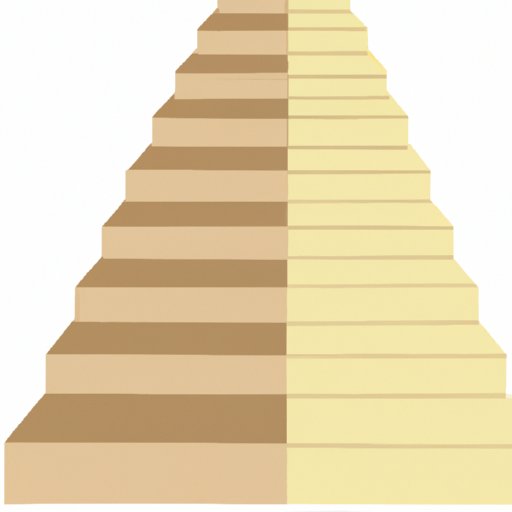I. Introduction
Have you ever marveled at the towering skyscrapers or intricate designs of your favorite architecture marvels? Trigonometry is a crucial component involved in creating these incredible structures. From the angles used in building foundations to the calculations used in designing the roof, trigonometry plays a fundamental role in architecture. In this article, we will explore the different applications of trigonometry in architecture and how it shapes today’s most iconic landmarks.
II. Exploring the Different Applications of Trigonometry in Architecture
Trigonometry is used in architecture in a variety of ways. Architects utilize trigonometric functions such as sine, cosine, and tangent to determine angles, lengths, and heights necessary for construction. Measuring the heights of buildings, determining safe angles for stairs, and specifying the height of a roof are just a few examples of applications using trigonometry. Without these calculations, architects would be unable to design reliable structures.
Trigonometry is essential in accurately determining the sizes and angles of architectural plans. It is important for these measurements to be precise in order to create a sound foundation for the building. There are many famous landmarks that reflect successful trigonometric applications, including the Eiffel Tower and the Burj Khalifa.
III. The Math Behind Architectural Design: A Look at Trigonometry’s Role
Trigonometry is a branch of mathematics that focuses on the relationships between the angles and sides of triangles. In architecture, trigonometry is vital to accurately calculating angles, length distances, and heights of buildings. Trigonometry is used in architectural design to determine the measurements required to ensure a structurally sound building.
Architects use trigonometry when creating designs such as blueprints and 3D models. In doing so, they define the angles and relative lengths of various building elements, ensuring the structural stability of the building. Trigonometric calculations are critical to an architect’s ability to accurately design and construct a building that is both safe and aesthetically pleasing.
IV. From Angles to Buildings: How Trigonometry Shapes Architecture
Trigonometry plays an essential role in architecture by influencing several factors relating to a building’s stability. These include the slope, angle, and structure of the building itself. Trigonometry helps architects create stable buildings by ensuring necessary measurements are correct.
One of the most significant ways that trigonometry shapes architecture is by providing insight into stability. When creating a building, architects must ensure that the structure can withstand weight and withstand natural disasters such as floods, earthquakes and hurricanes. By using trigonometric formulas, architects can ensure foundations, and walls are equal and stable, making the structure more durable and resilient against unforeseen circumstances.
V. Trigonometry and Architecture: Building the Future with Math
Advancements in technology have positively impacted architecture, making trigonometry even more critical than ever. The advancements have created opportunities for the use of computer programs to calculate trigonometric functions. The use of these tools has made it easier for architects to design complex structures by focusing on the trigonometric requirements in various areas of buildings, grounds, and slopes.
Certain famous architectural marvels of today were created using trigonometric applications. For example, the new Apple headquarters in Cupertino was designed by using trigonometry to generate a massive circular structure, with precise angles in the design. Architects will continue to use trigonometry as they create and design futuristic buildings and other structures. The advancements in technology and data processing capabilities give architects the ability to create even more complex buildings with incredible designs.
VI. How a Solid Understanding of Trigonometry can Elevate Your Architectural Designs
Trigonometry is an essential field of study for aspiring architects. Having a strong understanding of trigonometry can help architects create more prominent, stable and aesthetically-pleasing structures. Architects can use trigonometric formulas when designing and building structures in a way that reduces design flaws. A good understanding of trigonometry and its applications in architecture can help architects translate the theoretical concepts into effective and innovative building designs.
It’s important for architects to incorporate trigonometry into their design concept. For example, they can utilize trigonometry while modifying the buildings’ structure to improve the layout and angles. It can also be used to calculate the height of the roofs, which can increase their stability. Architects can bring their designs to the next level by incorporating trigonometry and focusing on building stability and design aesthetics at the same time.
VII. Conclusion
Trigonometry is a cornerstone of architecture and an essential element for creating awe-inspiring designs. By using trigonometry in the design process, architects can not only create beautiful structures but also ensure that those structures are safe and structurally sound. It is essential for architects to have a solid understanding of trigonometry and incorporate it into their building designs. Architectural designs created with trigonometric calculations are durable and sustainable, making them not only impressive design prowess but also functional structures for years to come.
(Note: Is this article not meeting your expectations? Do you have knowledge or insights to share? Unlock new opportunities and expand your reach by joining our authors team. Click Registration to join us and share your expertise with our readers.)
